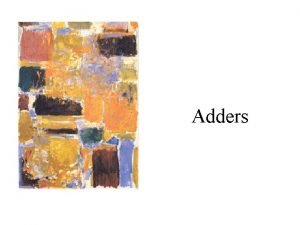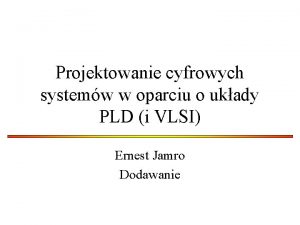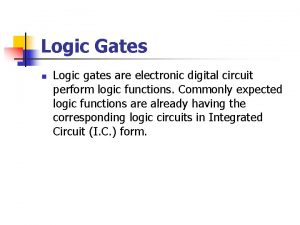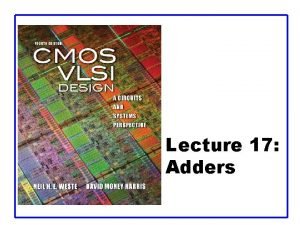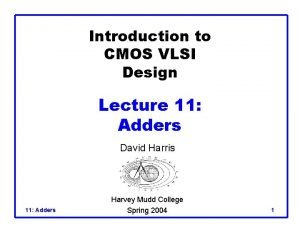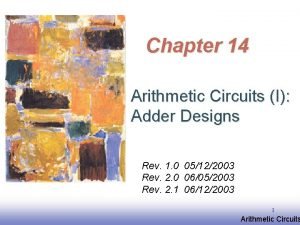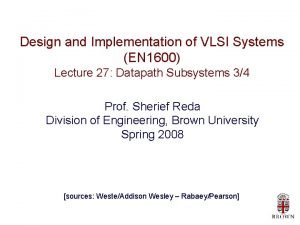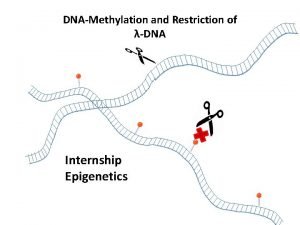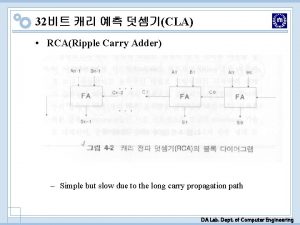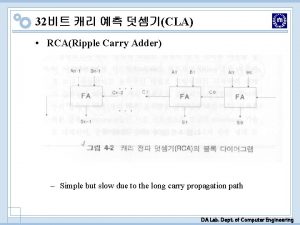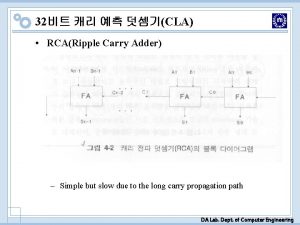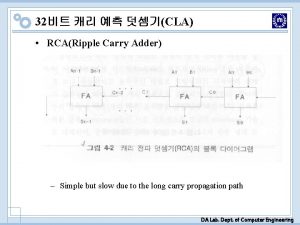How does CLA carry lookahead adder work Weijen














- Slides: 14

How does CLA (carry lookahead adder) work? Wei-jen Hsu TA for EE 457 at USC, fall 2004 Modified fall 2005

A simple one-bit full adder A B Cout (+) Cin S It takes A, B, and Cin as input and generates S and Cout in 2 gate delays (SOP)

4 -bit RCA A 3 B 3 C 4 (+) Carry propagation forms a long sequential wait chain, hence RCA S 3 Is slow!! A 2 B 2 C 3 (+) S 2 A 1 B 1 C 2 (+) S 1 A 0 B 0 C 1 (+) C 0 S 0 • Work from lowest bit to highest bit sequentially. • With A 0, B 0, and C 0, the lowest bit adder generates S 0 and C 1 in 2 gate delay. • With A 1, B 1, and C 1 ready, the second bit adder generates S 1 and C 2 in 2 gate delay. • Each bit adder has to wait for the lower bit adder to propagate the carry.

Observations • The critical component each bit adder waits for is the carry input. • Instead of generating and propagating carry bit-by-bit, can we generate all of them in parallel and break the sequential chain? • This is exactly the idea of CLA (carry lookahead adder).

Carry Look Ahead Logic • Now even before the carry in (Cin) is available, based on the inputs (A, B) only, can we say anything about the carry out? • Under what condition will the bit propagate an outgoing carry (Cout), if there is an incoming carry (Cin)? • Under what condition will the bit generate an outgoing carry (Cout), regardless of whethere is an incoming carry (Cin)?

1 -bit CLA adder A B S (+) p Cin g • Instead of Cout, an 1 -bit CLA adder block takes A, B inputs and generates p, g • p=propagator =>I will propagate the Cin to the next bit. p = A+B (If either A or B is 1, Cin=1 causes Cout=1) • g=generator =>I will generate a Cout independent of what Cin is. g = AB (If both A and B are 1, Cout=1 for sure) • p, g are generated in 1 gate delay after we have A, B. Note that Cin is not needed to generate p, g. • S is generated in 2 gate delay after we get Cin (SOP).

4 -bit CLA A B (+) p C 4 g A B C 3 (+) p g A B C 2 (+) p g A B C 1 (+) p C 0 g CLL (carry look-ahead logic) • The CLL takes p, g from all 4 bits and C 0 as input to generate all Cs in 2 gate delay. • C 1=g 0+p 0 C 0, • C 2=g 1+p 1 g 0+p 1 p 0 C 0, • C 3=g 2+p 2 g 1+p 2 p 1 g 0+p 2 p 1 p 0 c 0, • C 4=g 3+p 3 g 2+p 3 p 2 g 1+p 3 p 2 p 1 g 0+p 3 p 2 p 1 p 0 c 0 (Note: this C 4 is too complicated to generate in 2 -level SOP representation)

4 -bit CLA A 3 B 3 S 3 (+) p 3 g 3 A 2 B 2 C 3 S 2 (+) p 2 g 2 A 1 B 1 C 2 S 1 (+) p 1 g 1 A 0 B 0 (+) C 1 S 0 p 0 C 0 g 0 CLL (carry look-ahead logic) • Given A, B’s, all p, g’s are generated in 1 gate delay in parallel. • Given all p, g’s, all C’s are generated in 2 gate delay in parallel. • Given all C’s, all S’s are generated in 2 gate delay in parallel. • Key virtue of CLA: sequential operation in RCA is broken into parallel operation!!

Observation • The CLL block cannot be made too big (at most 4 bits) because if the equations for C’s are too long it cannot be evaluated in 2 gate delay. • So how about long operands, say 16 bits? • We add another layer of CLL and make a multi-level CLA.

16 -bit CLA • Same as before, p, g’s are generated in parallel in 1 gate delay • Now, without input carry, the first-tier CLL cannot generate C’s…… Instead they generate P, G’s (group propagator and group generator) in 2 gate delay P => This group will propagate the input carry to the group P=p 0 p 1 p 2 p 3 G => This group will generate a output carry G=g 3+p 3 g 2+p 3 p 2 g 1+p 3 p 2 p 1 g 0 • The second-tier CLL takes the P, G’s from first-tier CLLs and C 0 to generate “seed C’s” for first-tier CLLs in 2 gate delay. (note that the logic for generating “seed C’s” from P, G’s is exactly the same to generating C’s from p, g’s!) • With the seed C’s as input, the first-tier CLLs use Cin and p, g’s to generate C’s in 2 gate delay Therefore, totally • With all C’s in place, S’s are calculated in 2 gate delay 1+2+2=9 gate delay to finish the whole thing!!

Now, how about 64 -bit CLA? • You can visualize that in mind by yourself now, I guess.

A bit more details A 3 B 3 S 3 (+) p 3 C 4 g 3 A 2 B 2 C 3 S 2 (+) p 2 g 2 A 1 B 1 C 2 S 1 (+) p 1 g 1 A 0 B 0 C 1 S 0 (+) p 0 C 0 g 0 CLL (carry look-ahead logic) • Do all these 4 S’s (S 3, S 2, S 1, S 0) come together? Actually no! Since C 0 is available from the beginning, S 0 can be calculated in 2 gate delays (using original SOP expression for S bit in a single bit adder) (before S 3, S 2, S 1)

A bit more details (Cont’d) C 0 • Again, actually not all the S’s come together! • C 0 is readily available, so S 0 can be calculated in 2 gate delays. • Since C 0 is readily available, the lowest first-tier CLL can generate C 1, C 2, C 3 independent of the second-tier CLL. Since C 1, C 2, C 3 are done earlier, so is S 1, S 2, S 3. (in 5 gate delays. 1 for (p, g), 2 for (C 1, C 2, C 3), 2 for S) • When we get C 4, C 8, C 12, we can start to calculate S 4, S 8, S 12 and get them in 2 more gate delays. That is the same time when we get the other C’s (purple guys) at 7 gate delays. • Timing for items generated (in terms of gate delay): black=already available (and special case for S 0=4), orange=1, green=3, blue=5, purple=7, brown=9

Thanks!! (You can distribute these slides as one whole file to anywhere you feel it may be useful. )
 4 bit carry look ahead adder
4 bit carry look ahead adder Carry select adder
Carry select adder Carry propagate adder
Carry propagate adder Carry select adder verilog
Carry select adder verilog Full adder k map
Full adder k map Carry increment adder
Carry increment adder Carry increment adder
Carry increment adder Software engineering virtual lab iit kharagpur
Software engineering virtual lab iit kharagpur Llllc
Llllc Square root carry select adder
Square root carry select adder Manchester carry chain adder in vlsi
Manchester carry chain adder in vlsi Mast cla pneumallergenes
Mast cla pneumallergenes Cla 1 restriction enzyme
Cla 1 restriction enzyme Cla.quayn.eu
Cla.quayn.eu Multi word stage
Multi word stage

